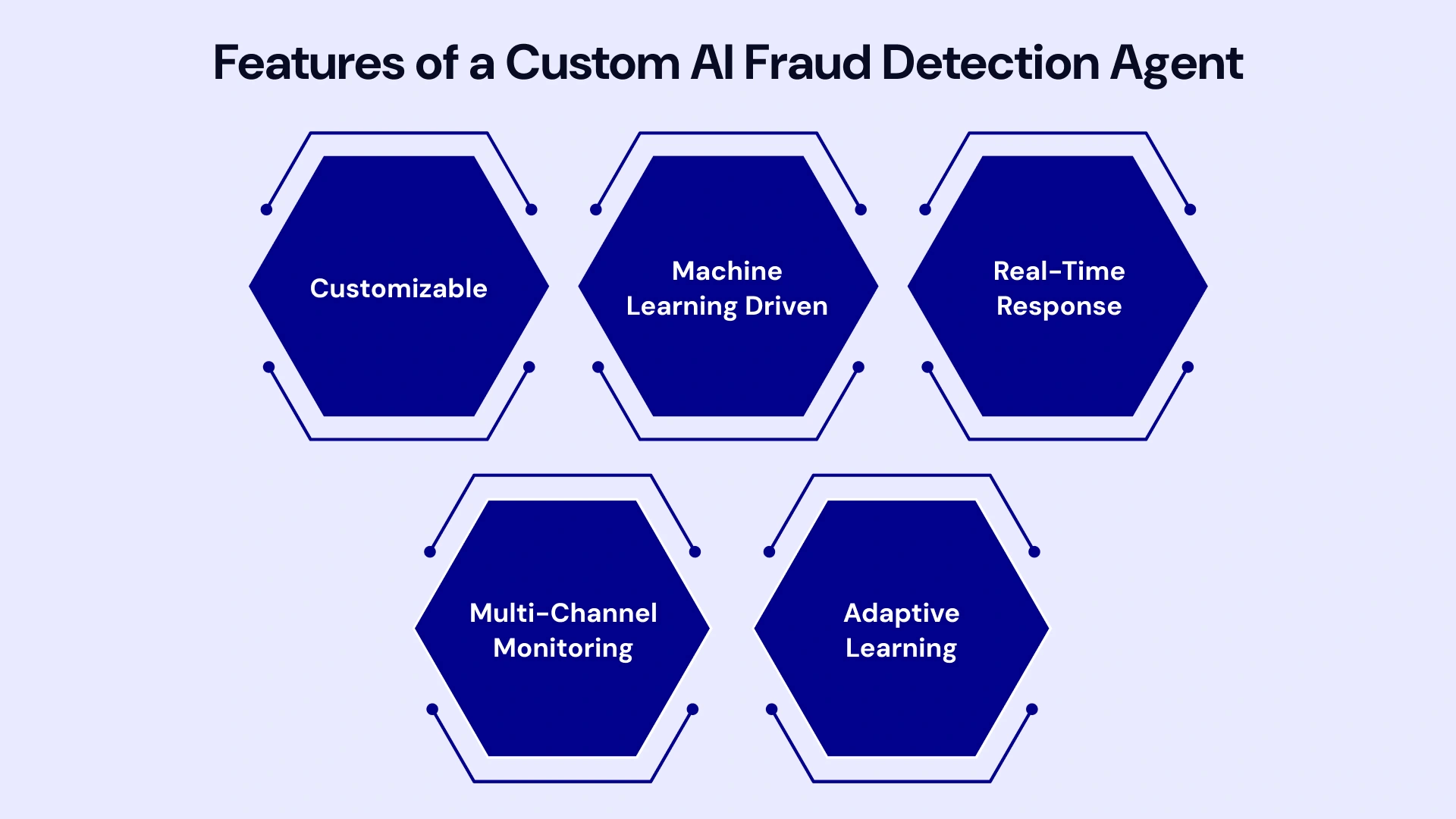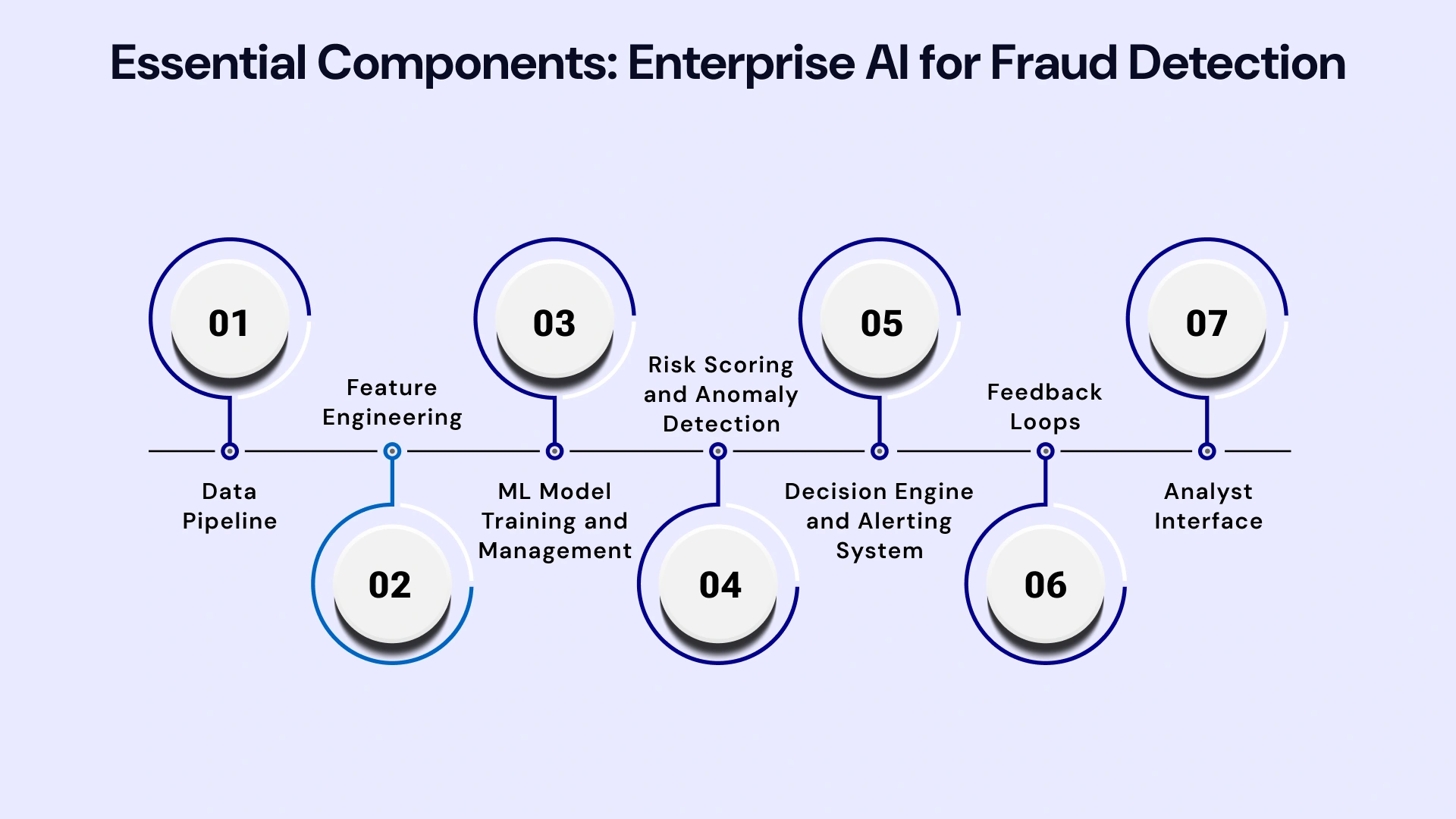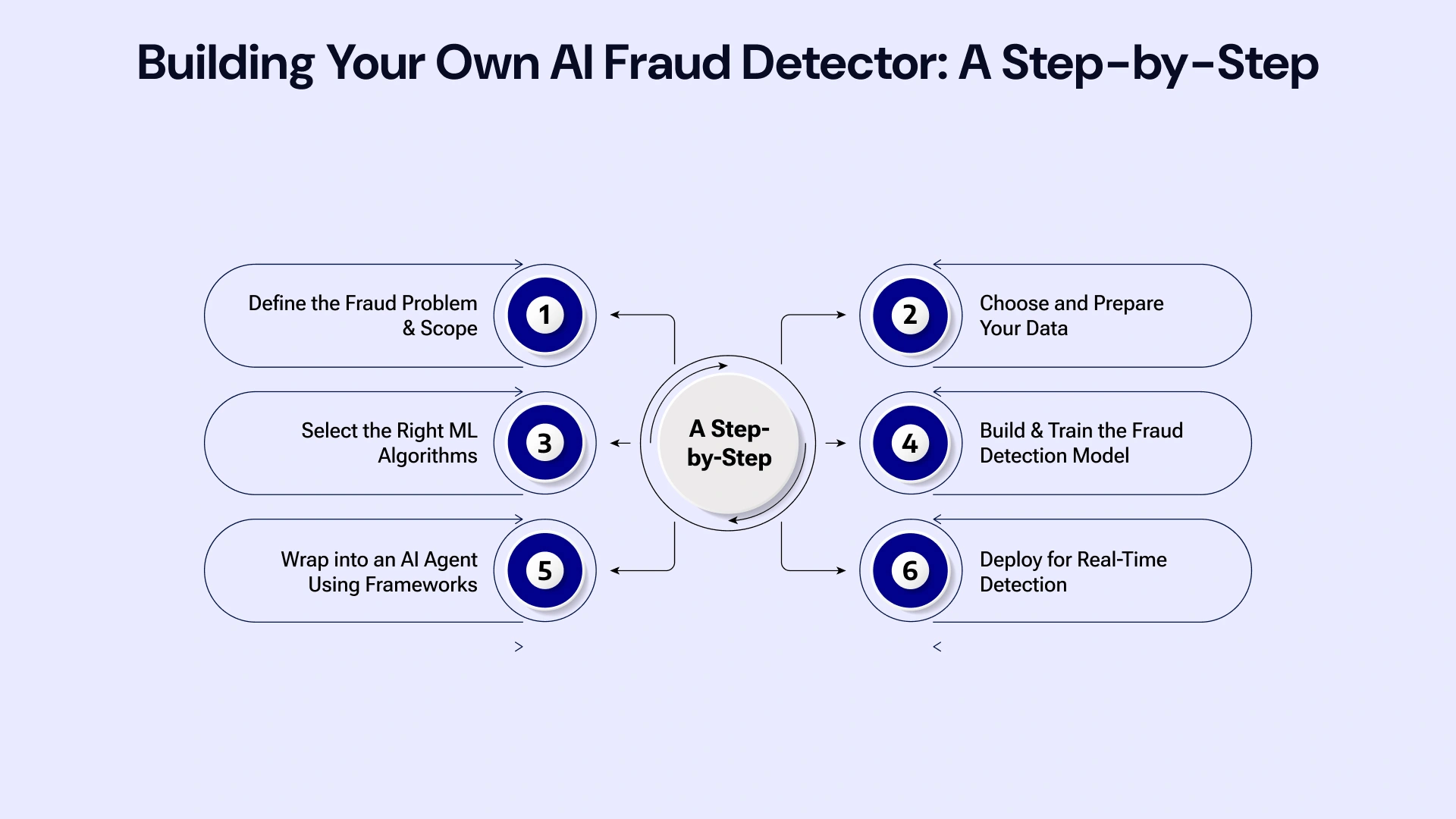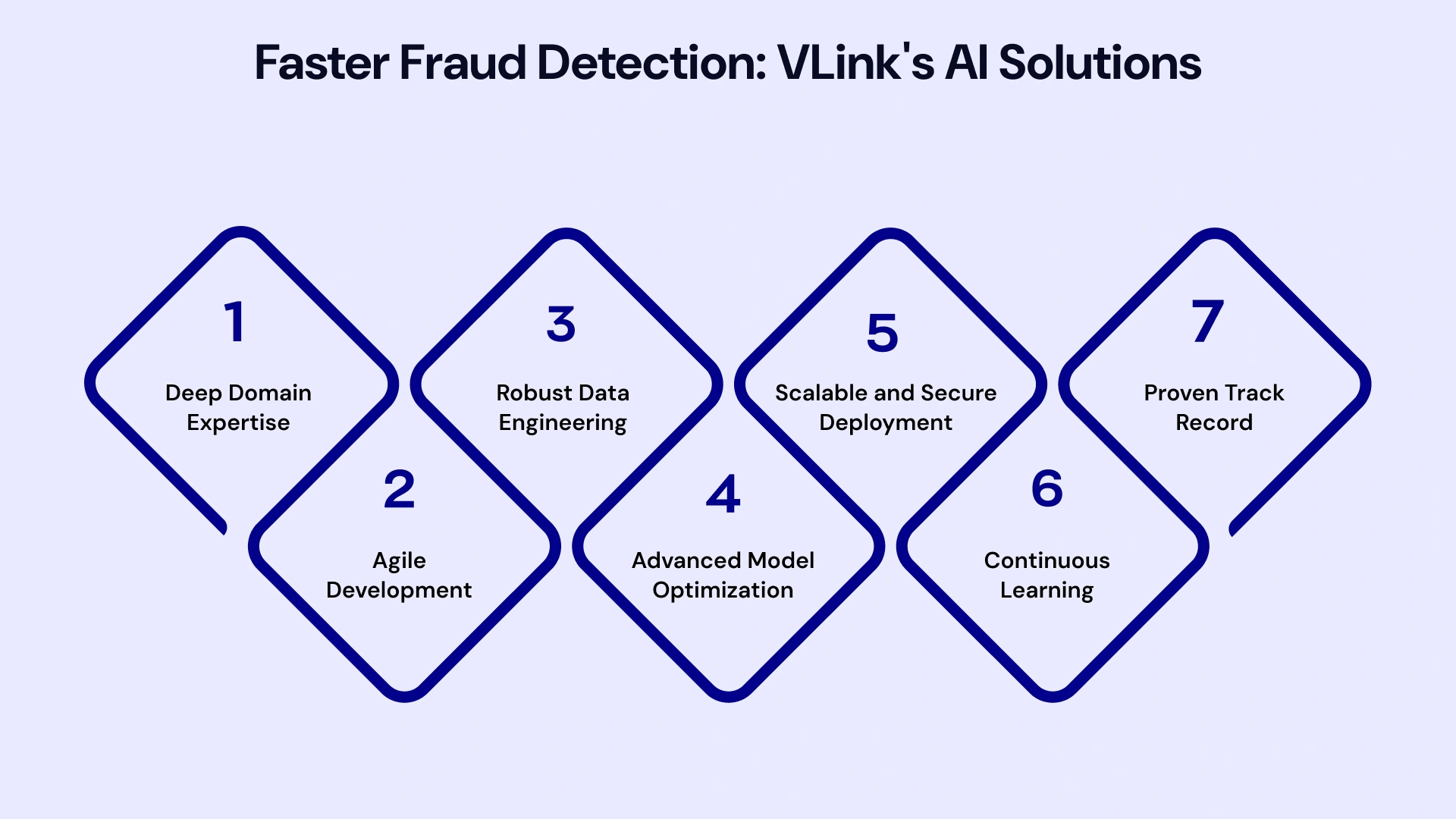The landscape of fraud is evolving at an unprecedented pace. Sophisticated cybercriminals are now leveraging generative AI to create more convincing deepfakes, highly personalized phishing attacks, and adaptive malware, making traditional rule-based defenses increasingly obsolete. Businesses are experiencing a surge in vendor fraud, wire transfer fraud, and even AI-powered impersonation attempts.
Some reports indicate that 90% of U.S. companies experienced cyber fraud in 2024, with nearly 60% reporting financial impacts exceeding $5 million. This urgent reality underscores the critical need for advanced, adaptive, and highly specialized fraud prevention.
A Custom AI Fraud Detection Agent is an advanced, AI-powered solution tailored to an enterprise’s specific data, workflows, and risk landscape. Unlike off-the-shelf tools, these agents leverage machine learning, real-time analytics, and adaptive feedback to detect and prevent fraud with greater accuracy and speed.
For CXOs, investing in a custom solution means not only staying ahead of evolving fraud challenges but also ensuring robust compliance, protecting valuable assets, and fortifying invaluable customer trust. It's about transitioning from reactive defense to proactive prevention, building an impenetrable shield against the most sophisticated modern threats.
What Is a Custom AI Fraud Detection Agent?
A Custom AI Fraud Detection Agent is a specialized software agent that uses machine learning, fraud detection, and advanced analytics to detect suspicious activities across enterprise systems. Unlike traditional rule-based systems, which rely on static, predefined rules, custom agents are dynamic—they learn from historical and real-time data, adapt to new fraud patterns, and operate autonomously with minimal human intervention. This makes them a superior fraud detection system for complex, high-volume environments.
Key Features of a Custom AI Fraud Detection Agent

- Customizable: These agents are meticulously built to fit the enterprise’s unique data sources, transaction types, and specific risk scenarios. This ensures that the custom fraud detection system is perfectly aligned with the organization's operational realities.
- Machine Learning Driven: At its core, a Custom AI Fraud Detection Agent continuously improves detection accuracy by learning from new data and feedback. This adaptive learning capability is crucial for combating rapidly evolving fraud schemes.
- Real-Time Response: One of the most significant advantages is the agent's ability to instantly flag or block suspicious transactions, drastically reducing exposure to fraud and preventing financial losses before they occur. This is the essence of a real-time fraud detection system.
- Multi-Channel Monitoring: A robust agent scans across web, mobile, APIs, and internal systems for coordinated attacks, providing a holistic view of potential fraud. This comprehensive monitoring is crucial for enterprises to detect AI fraud.
- Adaptive Learning: Continuously retrain and updates its models based on new data and patterns, ensuring it remains effective against emerging threats.
Why Traditional Rule-Based Systems Fail:
Traditional fraud detection methods, often static and rigid, are increasingly inadequate in the face of modern, AI-powered fraud tactics.
- Static Rules: They simply can't adapt to new and rapidly changing fraud tactics. A rule designed for one type of phishing attack may be useless against a new, AI-generated variant.
- High False Positives: Legitimate transactions frequently get flagged, leading to frustrated customers, increased operational costs due to manual reviews, and a degraded user experience.
- Manual Updates: Traditional systems require constant human intervention to update rules and stay relevant, a labor-intensive and often slow process that lags behind the evolving needs of fraudsters.
- Limited Scope: They cannot typically correlate disparate data points across various channels, making them blind to sophisticated, multi-pronged attacks.
Core Components of an Enterprise-Ready AI Fraud Detection System
Building a robust AI-powered fraud prevention tool requires integrating several key components, each optimized for real-time, high-volume enterprise environments, particularly for applications like artificial intelligence fraud detection in banking.

1. Data Pipeline (Real-Time Ingestion):
- Ingests data from multiple sources: transactions, user behavior, device metadata, external threat intelligence feeds, and more.
- Supports streaming data for instant analysis, which is critical for a real-time fraud detection system. This ensures that the system can process information in real-time, enabling immediate intervention.
2. Feature Engineering:
- This crucial step involves transforming raw data into meaningful features that the fraud detection algorithms can effectively utilize. Examples include transaction velocity, geolocation, device changes, IP reputation, and behavioral anomalies.
- Practical feature engineering is a cornerstone of robust machine learning fraud detection.
3. ML Model Training and Management:
- Uses historical labeled data to train diverse AI models for transaction fraud, such as XGBoost for tabular data, LSTM for sequential data (like transaction histories), and various anomaly detection algorithms for unsupervised identification of novel fraud patterns.
- Continuously re-trains with new data and feedback to adapt to emerging fraud patterns. This iterative learning process is vital for maintaining high accuracy in the face of constantly evolving threats.
4. Risk Scoring and Anomaly Detection:
- Assigns granular risk scores to transactions based on model predictions. These scores help prioritize alerts and automate responses.
- Detects anomalies by comparing current activity to learned patterns of legitimate behavior. This is where detecting fraud with AI truly shines pinpointing deviations that indicate fraudulent activity.
5. Decision Engine and Alerting System:
- Based on risk scores and predefined thresholds, the system makes automated decisions: it blocks the transaction, flags it for review, or allows it.
- Generates real-time alerts for suspicious activities, pushing notifications to relevant teams (e.g., fraud analysts, security operations centers).
6. Feedback Loops:
- Incorporates analyst feedback, investigation outcomes, and new fraud intelligence to refine models.
- This continuous learning process reduces false positives and significantly improves detection accuracy over time, making the Custom AI Fraud Detection Agent smarter with every interaction.
7. Analyst Interface:
- Provides a user-friendly interface for human analysts to review flagged transactions, access relevant data, conduct investigations, and provide feedback to the system. This blends the power of artificial intelligence in fraud prevention with human expertise.
Typical Architecture Diagram: A Symphony of Components
| Component | Functionality |
| Data Ingestion | Real-time streaming from multiple internal & external sources |
| Feature Engineering | Extracts relevant features for ML models |
| Model Training | Builds, validates, and updates fraud detection algorithms |
| Scoring Engine | Assigns dynamic risk scores to transactions |
| Decision Engine | Applies rules and ML predictions to decide action |
| Alerting System | Flags or blocks suspicious activities in real-time |
| Feedback Loop | Retrains models with new outcomes & insights |
Analyst Interface
| Allows human review, investigation, and feedback
|
How to Build a Custom AI Fraud Detection Agent
Building a Custom AI Fraud Detection Agent is a multi-step process that demands expertise in data science, machine learning, and enterprise system integration. It's about leveraging the power of AI Development Service and ML Development Service to address a critical business challenge.

1. Define the Fraud Problem & Scope
Before diving into technical details, clearly articulate what you aim to achieve.
- Identify the specific types of fraud most relevant to your business (e.g., payment fraud, account takeover, claims fraud, AI phishing detection, synthetic identity fraud).
- Set clear, measurable objectives: reduce false positives by X percentage points, improve detection speed to Y milliseconds, and ensure compliance with specific regulations (e.g., PCI-DSS, GDPR). Understanding the scope is vital for targeted enterprise fraud detection solutions.
2. Choose and Prepare Your Data
Data is the lifeblood of any Custom AI Fraud Detection Agent.
- Gather comprehensive historical transaction data, user behavior logs, device fingerprints, geolocation data, IP addresses, historical fraud patterns, and external threat intelligence. The more diverse and granular your data, the more effective your fraud detection algorithms will be.
- Clean and label data meticulously for supervised learning (clearly identifying fraud vs. non-fraud instances). This often requires significant manual effort initially, but it's crucial for model accuracy.
- Engineer features such as transaction velocity, frequency, value, time of day, device changes, new IP addresses, and unusual spending patterns. These features are what the AI models for transaction fraud will learn from.
3. Select the Right ML Algorithms
The choice of algorithms depends on the nature of your data and the fraud patterns you're targeting.
- XGBoost: Highly effective for tabular transaction data and risk scoring with machine learning due to its speed and accuracy. It's excellent for identifying patterns in structured data.
- LSTM (Long Short-Term Memory Networks): Useful for sequential data, such as transaction histories or user session data, to detect anomalies in behavior over time.
- Anomaly Detection Algorithms: For unsupervised detection of new, unknown fraud patterns that haven't been seen before. This is particularly relevant for combating emerging threats, such as those leveraging generative AI for fraud detection.
- Graph Neural Networks (GNNs): Excellent for identifying fraudulent rings by analyzing relationships between entities (e.g., users, devices, accounts) in a network.
Example (Python, XGBoost for a basic fraud classifier):
Python import xgboost as xgb from sklearn.model_selection import train_test_split from sklearn.metrics import accuracy_score, precision_score, recall_score, f1_score # Assume 'features' are your engineered data, and 'labels' are '0' for legitimate, '1' for fraud # Prepare data - splitting into training and testing sets X_train, X_test, y_train, y_test = train_test_split(features, labels, test_size=0.2, random_state=42, stratify=labels) # Train model - XGBoost Classifier model = xgb.XGBClassifier(objective='binary:logistic', eval_metric='logloss', use_label_encoder=False) model.fit(X_train, y_train) # Predict on the test set y_pred = model.predict(X_test) # Evaluate the model print(f"Accuracy: {accuracy_score(y_test, y_pred):.4f}") print(f"Precision: {precision_score(y_test, y_pred):.4f}") print(f"Recall: {recall_score(y_test, y_pred):.4f}") print(f"F1-Score: {f1_score(y_test, y_pred):.4f}")4. Build & Train the Fraud Detection Model
- Train the model on your labeled data, iteratively refining its parameters to improve its accuracy.
- Validate using cross-validation and independent test sets to ensure generalization.
- Optimize for key metrics: precision (minimizing false positives, crucial for a positive customer experience), recall (maximizing true positives, essential for detecting fraud), and F1-score (striking a balance between precision and recall) to achieve the desired balance between detection and false alarms.
5. Wrap into an AI Agent Using Frameworks
- Use robust frameworks like Langchain or develop custom logic to encapsulate your trained fraud detection machine learning model into an intelligent Custom AI Fraud Detection Agent.
- Integrate this agent with your existing enterprise systems via high-performance APIs for real-time scoring and action. This allows the agent to receive transaction data, process it, and return a risk score or decision almost instantaneously.
6. Deploy for Real-Time Detection
- Deploy the Custom AI Fraud Detection Agent on-premises for maximum control over sensitive data and strict compliance, or leverage cloud platforms (AWS, Azure, Google Cloud) for scalability, managed services, and faster deployment.
- Set up real-time monitoring, alerting, and automated response mechanisms (e.g., automatically decline high-risk transactions, flag for manual review, trigger step-up authentication). This is the crucial step where the real-time fraud detection system goes live.
Deploying and Scaling Your Fraud Detection Agent
The effectiveness of your Custom AI Fraud Detection Agent hinges on its deployment strategy and ability to scale with your enterprise's growing needs.
Deployment Options:
- On-Premises: This option offers greater control over data security, especially for highly sensitive information and organizations with stringent compliance requirements. It necessitates significant upfront infrastructure investment and internal IT expertise.
- Cloud (AWS, Azure, Google Cloud): Cloud deployments provide unparalleled scalability, faster deployment times, and access to a wide range of managed services that simplify operations. This is often the preferred choice for enterprises seeking agility and reduced operational overhead. Cloud providers also offer robust security measures and compliance certifications.
Monitoring and Feedback: The Engine of Continuous Improvement:
- Continuous Monitoring: Track key performance indicators (KPIs) rigorously, including model accuracy, latency (the time it takes for a transaction to be processed), false positive rates, false negative rates, and the overall impact on fraud losses. Dashboards and automated alerts are essential.
- Implement Continuous Feedback Loops: This is paramount for the long-term success of any AI fraud detection software. Analyst feedback from manual reviews, confirmed fraud cases, and even legitimate transactions that were incorrectly flagged must be fed back into the system to retrain and refine the AI models for transaction fraud.
This adaptive learning ensures the Custom AI Fraud Detection Agent remains effective against evolving fraud tactics, including sophisticated generative AI fraud detection methods.
Security and Compliance: Non-Negotiable Imperatives:
- Data Security: Implement robust encryption for data at rest and in transit. Employ strict access controls (following the principle of least privilege) to sensitive fraud data. Conduct regular security audits and penetration testing.
- Regulatory Compliance: Ensure your enterprise fraud detection solutions comply with all relevant industry regulations and data privacy laws, such as PCI-DSS (Payment Card Industry Data Security Standard) for payment data, GDPR (General Data Protection Regulation) for European user data, CCPA (California Consumer Privacy Act), and industry-specific regulations (e.g., banking regulations for artificial intelligence fraud detection in banking). Designing for auditability and transparency from the outset is crucial. Maintain comprehensive audit trails of all decisions made by the AI agent.
Common Pitfalls in Building AI Fraud Systems
While the promise of artificial intelligence in fraud prevention is immense, enterprises often encounter specific challenges during the implementation process. Addressing these proactively is key to building a successful fraud detection system.
1. Data Imbalance: The Silent Killer
Fraudulent transactions are inherently rare compared to legitimate ones, leading to severely imbalanced datasets. This can cause fraud detection algorithms to become biased, classifying most transactions as legitimate and failing to detect actual fraud (high false negatives).
Employ various techniques to handle data imbalance during model training. These include:
- Oversampling: Duplicating or generating synthetic samples of the minority class (fraudulent transactions) using methods like SMOTE (Synthetic Minority Over-sampling Technique).
- Undersampling: Reducing the number of samples in the majority class (legitimate transactions).
- Cost-sensitive learning: Assigning higher penalties for misclassifying fraud instances.
- Ensemble methods: Combining multiple models to improve performance on imbalanced data.
2. Model Interpretability: The "Black Box" Problem
Many advanced machine learning fraud detection models (e.g., deep neural networks) are "black boxes," making it difficult to understand why they made a particular fraud decision. This lack of transparency can be problematic for regulatory compliance, internal audits, and gaining stakeholder trust.
Embrace explainable AI (XAI) tools and methodologies.
- LIME (Local Interpretable Model-agnostic Explanations): Explains individual predictions by approximating the black-box model locally with an interpretable model.
- SHAP (SHapley Additive exPlanations): Assigns an importance value to each feature for a prediction, based on game theory.
- Feature importance: Understand which features contribute most to the model's decisions.
- Maintain comprehensive audit trails: Documenting model versions, training data, and decision logic provides a verifiable record of the system's operation. For artificial intelligence fraud detection in banking, this is particularly critical.
3. Regulatory Challenges: Navigating a Complex Landscape
Compliance with evolving data privacy regulations (such as GDPR and CCPA), anti-money laundering (AML) laws, and industry-specific mandates is complex and constantly changing. Non-compliance can result in substantial fines and reputational damage.
Design your Custom AI Fraud Detection Agent for compliance from the start.
- Privacy by Design: Incorporate data anonymization, pseudonymization, and strict access controls.
- Built-in Auditability: Ensure all decisions, data inputs, and model versions are logged and auditable.
- Regular Legal Review: Continuously consult with legal and compliance teams to ensure the system meets the latest regulatory requirements.
4. High False Positives: Customer Frustration and Operational Burden
Overly sensitive models, while effective at catching fraud, can flag too many legitimate transactions, frustrating customers, leading to abandoned transactions, and increasing the burden on manual review teams, thereby negating some of the benefits of real-time fraud detection agents.
Fine-tune model thresholds carefully, balancing precision and recall based on your organization's risk appetite.
- Implement continuous feedback loops: As mentioned, use analyst feedback to reduce false positives over time.
- Combine ML with rule-based checks: A hybrid approach can leverage the strengths of both. ML identifies complex patterns, while targeted rules can catch known, low-risk cases or enforce specific business policies.
- Step-up authentication: Instead of outright blocking, trigger additional verification steps for moderately suspicious transactions, improving customer experience.
Cost and ROI of Building a Custom Fraud Detection Agent
The decision to build a fraud detection system using AI is a strategic investment. Understanding the Total Cost of Ownership (TCO) and potential Return on Investment (ROI) is critical for securing executive buy-in for your enterprise fraud detection solutions.
Total Cost of Ownership (TCO):
The TCO for a Custom AI Fraud Detection Agent encompasses several key areas:
- Data Infrastructure: Costs associated with data storage, real-time data pipelines, and data warehousing. This can involve cloud services (e.g., S3, BigQuery, Kafka) or on-premises hardware.
- Model Development: This includes the cost of data scientists, machine learning engineers, and potentially consultants from an AI Development Service. It covers data preparation, feature engineering, model training, validation, and optimization.
- Deployment and Integration: Expenses related to deploying the AI agent, integrating it with existing enterprise systems (CRMs, ERPs, payment gateways), and setting up API infrastructure.
- Ongoing Maintenance and Operations: This is a continuous cost and includes model monitoring, retraining, infrastructure scaling, software updates, and the ongoing salaries of fraud analysts and data science teams responsible for managing the system.
In-House vs. Outsourcing: A Strategic Decision
| Option | Pros | Cons |
| In-House | Full control over development, tailored solution, IP retention, and deep domain expertise within the organization. | Higher upfront cost, longer time to deploy, and requires significant internal talent acquisition. |
| Outsourcing | Faster deployment, access to specialized AI Development Service and ML Development Service expertise, reduced upfront burden, often more cost-effective for initial build. | Less customization post-deployment, ongoing vendor fees, potential reliance on external parties, IP considerations. |
PRO TIPS:- For complex AI fraud detection for enterprises, a hybrid approach often works best: outsourcing the initial build to accelerate time-to-market and leverage specialized skills, while simultaneously building internal capabilities for ongoing maintenance and future enhancements.
ROI Projection Example: The Tangible Benefits
The benefits of custom AI fraud detection agents are substantial, leading to a strong ROI.
Savings:
- Reduced Fraud Losses: This is the most direct and significant saving. By catching more fraud in real-time, enterprises prevent billions of dollars in losses. Projections suggest AI can reduce fraud losses by 30-50%.
- Lower Manual Review Costs: Automated detection and decision-making significantly reduce the need for manual review teams, leading to substantial operational cost savings and increased efficiency.
- Improved Customer Retention: Fewer legitimate transactions are declined, resulting in a smoother customer experience, higher satisfaction, and lower churn rates.
- Reduced Regulatory Fines: Proactive fraud prevention and robust compliance mechanisms mitigate the risk of costly regulatory penalties.
- Enhanced Reputation: A robust security posture fosters trust among customers, partners, and investors.
Investment:
- Initial build and development costs.
- Cloud or on-premises infrastructure resources.
- Ongoing tuning, monitoring, and retraining of AI models for transaction fraud.
Example Scenario:
An e-commerce enterprise experiencing $10 million in annual fraud losses and spending $2 million on manual reviews could, with a Custom AI Fraud Detection Agent, potentially reduce fraud losses by 40% ($4 million saved) and cut manual review costs by 50% ($1 million saved). Even with an initial investment of $1.5 million for development and $500,000 annually for operations, the payback period could be less than a year, with significant ongoing annual savings.
Industry Use Cases of AI-Powered Fraud Detection
AI-powered fraud prevention tools are revolutionizing security across various industries, proving to be significantly more effective than traditional risk monitoring methods.
FinTech (Credit Card Fraud, Banking, Payments):
- Use Case: Real-time detection of suspicious credit card transactions, unauthorized payments, and adaptive authentication for online banking.
- How AI Helps: Artificial intelligence in fraud detection for banking analyzes vast streams of transactional data, user behavior, and historical patterns to identify anomalies (e.g., unusual spending habits, new device logins, and geographically impossible transactions). It can automatically block transactions or trigger step-up authentication (e.g., OTP) for high-risk activities. The ability of AI models to adapt quickly to transaction fraud is crucial in this fast-moving sector.
E-commerce (Account Takeover, Payment Fraud, Refund Abuse):
- Use Case: Identifies unusual login patterns, device changes, rapid purchase attempts, and fraudulent refund requests to prevent account hijacking and payment fraud.
- How AI Helps: AI fraud detection software monitors customer journeys, analyzes clickstream data, IP addresses, and device fingerprints to identify potential fraudulent activity. It can detect bots attempting account takeovers, identify synthetic identities used for fraudulent purchases, or flag patterns indicative of refund abuse, ensuring secure online shopping experiences. The use of generative AI for fraud detection is becoming increasingly important in combating sophisticated attempts.
Insurance (Claims Fraud):
- Use Case: Flags exaggerated or duplicate claims, analyzes claim narratives for inconsistencies, and cross-references external data for suspicious patterns.
- How AI Helps: Machine learning fraud detection in insurance can process vast amounts of unstructured data (e.g., accident reports, medical records, social media data) using Natural Language Processing (NLP) to identify discrepancies. It can detect collusion patterns, identify suspicious provider networks, and flag claims that deviate significantly from historical norms, saving insurers billions.
Telecommunications (Subscription Fraud, SIM Swap Fraud):
- Use Case: Detects fraudulent new account sign-ups, SIM swap attacks (where fraudsters take over a victim's phone number), and subscription abuse.
- How AI Helps: AI analyzes customer onboarding data, device activity, call patterns, and network behavior to identify suspicious new lines or account changes that could indicate fraud. AI phishing detection capabilities are also crucial in protecting customers from scam calls and messages.
Healthcare (Medical Claims Fraud, Identity Theft):
- Use Case: Identifies fraudulent medical claims, billing anomalies, and instances of patient identity theft for prescription or service abuse.
- How AI Helps: AI can analyze billing codes, patient histories, and provider networks to flag unusual patterns, duplicate claims, or suspicious relationships, safeguarding healthcare resources and patient data.
Build a Custom AI Fraud Detection Agent with VLink Expertise
Building an effective Custom AI Fraud Detection Agent is a complex strategic initiative demanding deep expertise in machine learning, data engineering, and secure deployment. VLink’s dedicated team offers end-to-end solutions, leveraging our team of senior AI architects, data scientists, and ML engineers with extensive experience in enterprise fraud detection solutions, particularly in sectors such as banking and artificial intelligence.
How VLink Accelerates Your Custom AI Fraud Detection Journey:

- Deep Domain Expertise: We possess a broad range of expertise in various types of fraud, including payment fraud and AI phishing detection, ensuring that your custom fraud detection system is precisely tailored to meet your specific needs.
- Agile Development: Our rapid prototyping and iterative refinement accelerate your development cycle for an effective fraud detection system.
- Robust Data Engineering: We build real-time data pipelines and employ advanced feature engineering for highly accurate fraud detection algorithms and AI models for transaction fraud.
- Advanced Model Optimization: We select and combine cutting-edge fraud detection algorithms, including those for generative AI fraud detection, optimizing for precision and interpretability.
- Scalable and Secure Deployment: We ensure seamless, secure, and compliant integration, whether on-premises or cloud-based, to establish a robust real-time fraud detection system.
- Continuous Learning: We establish monitoring and feedback loops to improve your Custom AI Fraud Detection Agent continually, ensuring it remains adaptive to new threats and refines risk scoring through machine learning.
- Proven Track Record: Our successful implementations demonstrate our ability to deliver measurable ROI, showing you how to detect fraud practically with AI.
Partner with VLink to empower your enterprise to proactively prevent fraud, securing your assets and reputation in today's complex digital landscape.
Wrap Up!
A custom AI fraud detection agent is not merely an upgrade; it's a fundamental shift in how enterprises protect themselves. It's about empowering your organization with a self-learning, real-time guardian capable of outsmarting the most cunning adversaries. By building a meticulously tailored fraud detection system that matches your unique operational footprint, you gain an unparalleled competitive advantage in security.
Don't let fraud erode your profits, damage your reputation, or undermine customer confidence. The time to act is now. Investing in a bespoke AI fraud detection for enterprises solution is an investment in your organization's future resilience and continued success in the digital economy.
Ready to fortify your enterprise against the next generation of fraud? Consult with our AI experts for a personalized consultation. Let us assess your unique risk profile, discuss your specific needs, and craft a bespoke AI development service solution that delivers unparalleled security and peace of mind.









 Shivisha Patel
Shivisha Patel

















